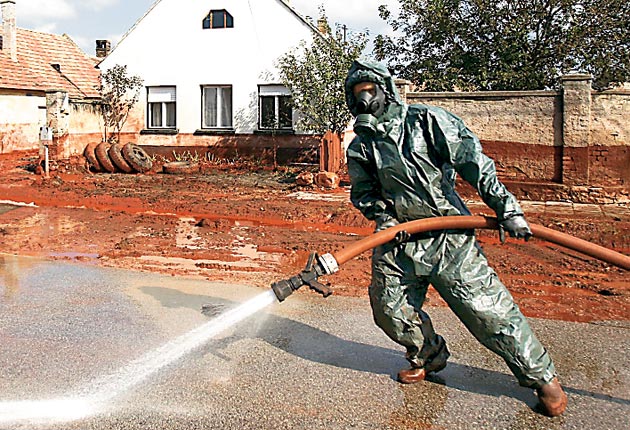Warnings over long-term effects of Danube slick

The River Danube may have avoided immediate environmental disaster, but Hungary's massive spill of red sludge could cause more long-term damage than previously thought, it was claimed yesterday.
The crimson tide of aluminium-plant waste reached the Danube on Thursday, but Hungarian ministers and officials were still insisting it did not present a major problem for Europe's second-longest river. Hungary's Interior Minister, Sandor Pinter, said the spill had not affected the drinking water supply so far and government spokeswoman Anna Nagy said the food chain was safe. Despite initial fears, Mr Pinter said that the pollution would be so diluted by the volume of water in the river that nations downstream, such as Serbia and Romania, would not be affected. "It will not be of an extent which would cause biological or environmental damage," he said.
Hungary's Prime Minister Viktor Orban said the threat to the Danube had been eliminated, and the International Commission for the Protection of the Danube, a Vienna-based group that monitors the river and its tributaries, said that the consequences "do not seem to be that dramatic".
However, assurances from the Hungarian Academy of Sciences which claimed that the sludge, which burst out of a containment reservoir near the village of Kolontar, did not contain harmful heavy metals were contradicted by Greenpeace. It said that laboratory tests showed high concentrations of heavy metals in the sludge which risked causing pervasive and lasting environmental damage in the Kolontar area.
Red sludge samples taken on Tuesday, a day after the spill, contained "surprisingly high" levels of arsenic and mercury, Greenpeace said. The campaigning group said its analysis suggested that roughly 50 tonnes of arsenic, 300 tonnes of chrome and half a tonne of mercury were unleashed by the spill. The detected arsenic concentration was twice the amount normally found in so-called red mud, a waste product in aluminum production. Analysis of water in a canal near the spill also found arsenic levels 25 times the limit for drinking water, Greenpeace said.
The warnings conflicted with the view of the prestigious academy, which reiterated yesterday that the red sludge remained hazardous due to its caustic alkalinity but its heavy metal concentrations were not considered dangerous for the environment.
Greenpeace said it had taken test samples from sludge in Kolontar, located closest to the burst reservoir of the alumina plant, showing that data taken by government health and science agencies had underestimated the ecological dangers unleashed. The group said its conclusion was supported by findings of the Federal Environmental Institute in Vienna and the Balint Analytical Institute in Budapest.
Zsolt Szegfalvi, director of Greenpeace Hungary, said arsenic, mercury and chromium levels were especially high at Kolontar. "This contamination poses a long-term risk to both the water base and the ecosystem," a Greenpeace statement said.
More than 150 people were injured in the disaster, with inhabitants suffering from burns and eye ailments caused by the sludge's caustic elements, while the death toll rose to seven yesterday, when rescue services found two more bodies near Devecser, a town in western Hungary inundated Monday by the sludge. Officials said they were probably residents missing from nearby Kolontar.
Subscribe to Independent Premium to bookmark this article
Want to bookmark your favourite articles and stories to read or reference later? Start your Independent Premium subscription today.

Join our commenting forum
Join thought-provoking conversations, follow other Independent readers and see their replies